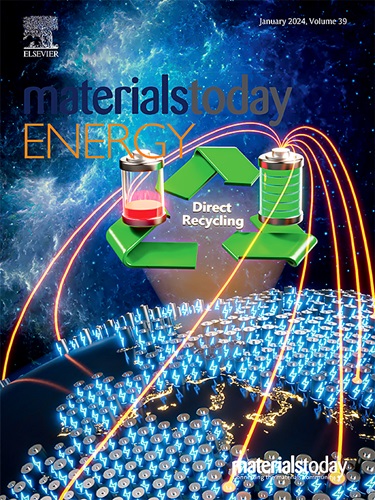Efficient hole transport layers for silicon heterojunction solar cells by surface plasmonic modification in MoOx/Au NPs/MoOx stacks
IF 8.6
2区 材料科学
Q1 CHEMISTRY, PHYSICAL
引用次数: 0
Abstract
This study explores the integration of Au nanoparticles (NPs) into molybdenum oxide (MoO) thin films to form a MoO/Au NPs/MoO (MAM) stack. This stack serves as a hole transport layer (HTL) in silicon heterojunction solar cells, aiming to address the challenges of safety concerns and inefficient carrier transport. Ultraviolet photoelectron spectroscopy and X-ray photoelectron spectroscopy spectra demonstrate that the incorporation of Au NPs notably raises the work function of MAM to 5.85 eV and stabilize Mo concentrations at 94.07%. In addition, Au NPs effectively act as a shield against detrimental interactions with Ag, thereby improving the interfacial stability between the back electrode and HTL. This strategic enhancement facilitates the formation of surface plasmon polaritons, reduces the contact resistance to 41.19 mΩ cm, and boosts the quantum efficiency by injecting hot electrons and intensifying the surface electric field. These advancements lead to a significant enhancement in the fill factor and short-circuit current, leading to the development of a heterojunction solar cell with an increased efficiency () from 19.81% to 22.03%. This investigation underscores the transformative potential of engineered nanomaterials in elevating the performance and stability of photovoltaic devices, promoting the wider adoption of renewable energy technologies.通过对氧化钼/金氧化物/氧化钼叠层进行表面等离子体修饰,为硅异质结太阳能电池提供高效空穴传输层
本研究探讨了如何将金纳米粒子(NPs)整合到氧化钼(MoO)薄膜中,形成氧化钼/金纳米粒子/氧化钼(MAM)叠层。这种叠层在硅异质结太阳能电池中用作空穴传输层(HTL),旨在解决安全问题和载流子传输效率低下的挑战。紫外光电子能谱和 X 射线光电子能谱光谱显示,加入金氧化物后,MAM 的功函数显著提高到 5.85 eV,钼浓度稳定在 94.07%。此外,金氧化物还能有效屏蔽与银的不利相互作用,从而提高背电极与 HTL 之间的界面稳定性。这种战略性的增强有利于表面等离子体极化子的形成,将接触电阻降至 41.19 mΩ cm,并通过注入热电子和增强表面电场来提高量子效率。这些进步显著提高了填充因子和短路电流,使异质结太阳能电池的效率()从 19.81% 提高到 22.03%。这项研究强调了工程纳米材料在提高光伏设备的性能和稳定性方面的变革潜力,促进了可再生能源技术的广泛应用。
本文章由计算机程序翻译,如有差异,请以英文原文为准。
求助全文
约1分钟内获得全文
求助全文
来源期刊

Materials Today Energy
Materials Science-Materials Science (miscellaneous)
CiteScore
15.10
自引率
7.50%
发文量
291
审稿时长
15 days
期刊介绍:
Materials Today Energy is a multi-disciplinary, rapid-publication journal focused on all aspects of materials for energy.
Materials Today Energy provides a forum for the discussion of high quality research that is helping define the inclusive, growing field of energy materials.
Part of the Materials Today family, Materials Today Energy offers authors rigorous peer review, rapid decisions, and high visibility. The editors welcome comprehensive articles, short communications and reviews on both theoretical and experimental work in relation to energy harvesting, conversion, storage and distribution, on topics including but not limited to:
-Solar energy conversion
-Hydrogen generation
-Photocatalysis
-Thermoelectric materials and devices
-Materials for nuclear energy applications
-Materials for Energy Storage
-Environment protection
-Sustainable and green materials
 求助内容:
求助内容: 应助结果提醒方式:
应助结果提醒方式:


